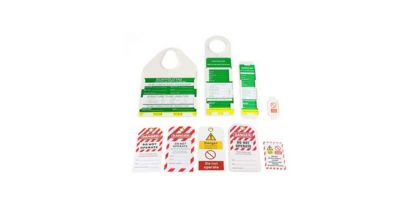- Whatsapp: +86-13396996593
- Email: [email protected]
During industrial machine maintenance and repair, safety is the top priority. The use of Lockout Tags is a key safety measure to ensure employees are not harmed while working on machinery. To understand who can remove a Lockout Tag, we first need to know what a Lockout Tag is, its purpose, and what conditions must be met before it can be removed.
A Lockout Tag is a type of safety label. Its bright colors make it stand out on equipment, alerting others to the machine’s status. Lockout Tags are commonly used during machine repair or maintenance to prevent accidental start-up. They are usually made of polyester, PVC, or metal, which ensures they are strong and durable. This design helps them remain clear and effective even in harsh industrial environments.

Source:PROLOCKEY
Safety is crucial, and a Lockout Tag is an important safety measure. It prevents accidental energy release and machine operation that could harm workers during maintenance or repairs.
Control Hazardous Energy: Lockout Tags have a locking function that secures the machine’s energy source during maintenance, preventing accidental energy release and serious safety incidents.
Prevent Accidental Start-Up: By controlling the hazardous energy, Lockout Tags cut off the machine’s power supply, ensuring the machine cannot be accidentally started during repairs.
Comply with Safety Regulations: Many countries and regions require the use of Lockout Tags during equipment maintenance to meet safety regulations.
Improve Workplace Safety: Safety during maintenance is vital for both personnel and equipment. Lockout Tags provide an effective measure to ensure safety by controlling energy at its source.
Increase Work Efficiency: By clearly marking the equipment’s status, Lockout Tags help keep maintenance work organized, reducing the chance of errors and accidents.
Before removing a Lockout Tag, some key conditions must be met to ensure the safety of equipment and employees:
Personnel Safety: Ensure that all maintenance personnel and others have left the danger zone, with no safety risks present.
Work Completed: All repair or maintenance work on the equipment has been completed as planned.
Thorough Inspection: Conduct a full inspection of the equipment and surrounding area. Make sure all tools and materials used during maintenance are removed, and all parts are fully installed with no visible safety hazards.
Follow Procedures: Strictly follow company policies and local laws to ensure every step complies with standard safety procedures.
Authorized Personnel: Only specific authorized personnel can remove the Lockout Tag. This ensures that the person removing the tag is fully knowledgeable about the equipment and maintenance process.
To prevent any accidents when removing a Lockout Tag, follow these steps carefully:
Inspect: Perform a final check before removing the tag. Make sure the equipment has been fully repaired, and all personnel are in a safe location.
Notify: After the inspection, inform the relevant personnel that the equipment is repaired and about to be restarted. Remind them to stay clear of the danger zone.
Remove: Once the first two steps are completed and safety is confirmed, only an authorized professional should remove the Lockout Tag. Do not allow anyone else to remove it. During this process, ensure others remain in a safe area.
Restore Power: After removing the Lockout Tag, follow the equipment’s start-up procedure to restore power.
Test: Before fully restarting the equipment, perform a test to ensure it operates correctly with no issues.
Document the Process: Record the removal process of the Lockout Tag and archive it for future reference.
Complete: Once all steps are completed, the equipment can be returned to normal use.
Compliance: In the United States, the Occupational Safety and Health Administration (OSHA) has specific regulations for Lockout Tag procedures. Companies and employees must strictly follow these regulations to ensure safety and compliance.
Employee Training: Employee awareness is crucial. Regular training should be provided to help employees understand and become familiar with the purpose and operation of Lockout Tags.
Regular Audits: Besides employee training, conduct regular audits of Lockout Tag procedures to ensure they meet company requirements and legal standards. Remove any non-compliant equipment and retrain employees if any non-compliance is found.
Record Keeping: Keep detailed records of the Lockout Tag removal process as required by law. These records are essential for future reference and compliance.
Safety is crucial for both companies and individuals. Through continuous training and education, employees can fully understand Lockout Tag safety, the conditions for moving it, and the required steps. By becoming skilled and familiar with standard procedures and strictly following the removal process, they can qualify as authorized personnel to remove Lockout Tags. This not only reduces workplace accidents but also ensures employee safety and enhances the company’s competitiveness.
Privacy Policy
Copyright Lockey Safety Products Co.,Ltd SUPPORT BY :JUNJ